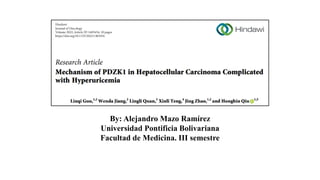
Mechanism of PDZK1 in Hepatocellular Carcinoma Complicated with Hyperuricemia
- 1. By: Alejandro Mazo Ramírez Universidad Pontificia Bolivariana Facultad de Medicina. III semestre
- 2. Introduction • Also known as hepatoma, its the most common type of primary liver cancer. It is often produced in people who have long-term diseases or bad habits, such as hepatitis virus type B or type C, being a long time smoker, heavy drinking or having cirrhosis. Hepatocellular Carcinoma
- 3. Hyperuricemia Introduction • Uric acid is the final product of the purine catabolism. When its levels in blood are high enough, aside from acidifying it, it may denote other metabolic syndromes. • Previous studies have proved that the serum uric acid level can increase the incidence rate and mortality of malignant tumors.
- 4. Objective • Finding the mechanism of PDZK1 in hepatocellular carcinoma complicated with hyperuricemia
- 5. Methods Flow Cytometry Assay RT-PCR Analysis In this study, single cells are rapidly analized as they pass through multiple lasers in a solution It can determine characteristics of certain cells or even identify tumor markers It is done to see if a certain genetic sequence is present when the study is done. Here they are evaluating the expression of a protein (PDZK1)
- 6. Methods Western blot assay In Vivo Tumorigenesis A sample of HCC was taken, and after some processing it was transplanted into mices with hiperuricemia. After sacrificing them a sample of tumor tissue was taken. This technique is used to detect a specific protein in a sample (blood or tissue are commonly used) It is used gel electrophoresis to separate proteins according to their molecular weight.
- 7. Results
- 8. Results
- 9. Discussion Author What they said Agree/Disagree M. Chen, X. Lu, C. Lu et al [35] In our study, the mRNA expression of PDZK1 was signifcantly increased after HCC after diferent concentrations of soluble uric acid treatment Agree I. Andia and E. Rubio- Azpeitia [36] On the other hand, the interaction between urate crystals and immune cells can enhance immunosuppression and promote angiogenesis Agree S. Vadakedath and V. Kandi[38–40] Regulatory PDZK1 expression can afect the proliferation, migration, and apoptosis of HCC; uric acid may cause tumor immune response. It suggests that PDZK1 may be related to tumor immunity Agree
- 10. • With the use of molecular biology new interactions between different diseases are being found, resulting in new treatments never thought to be found before Conclusions • The understanding of the different impacts that proteins have in the organism allow the emergence of new approachs to various diseases